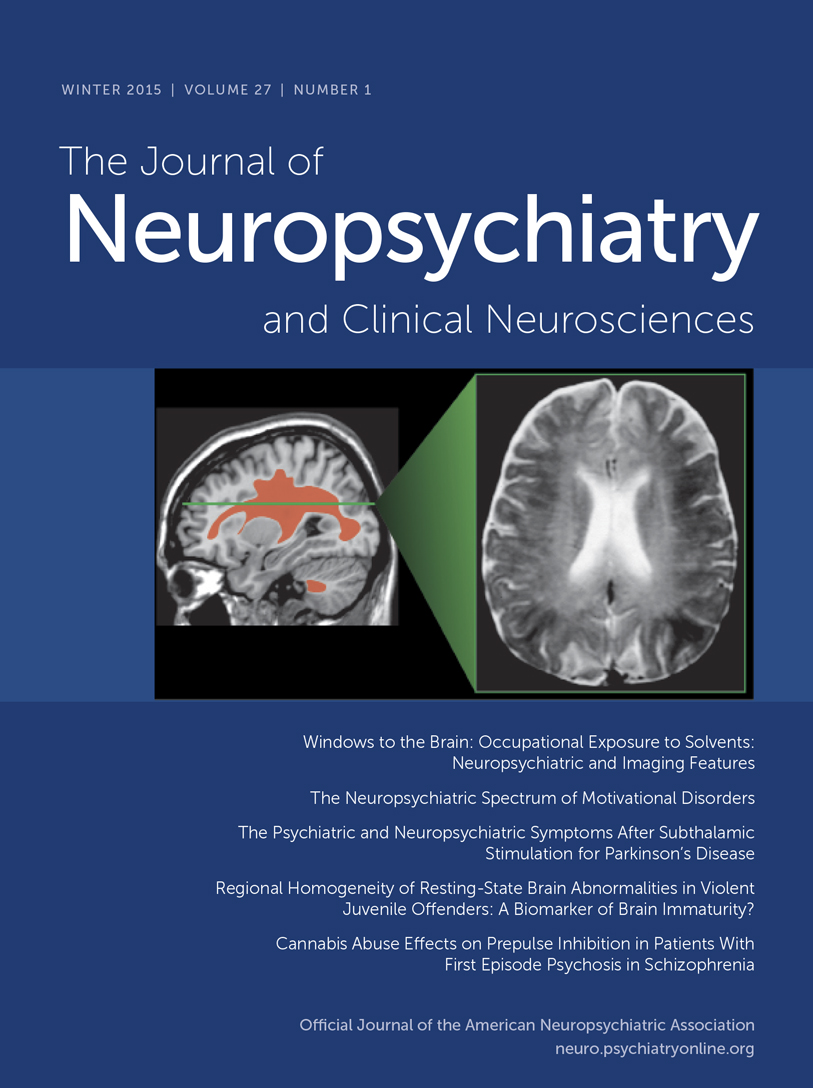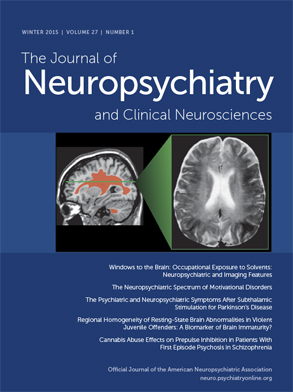To the Editor: We report two cases of transient childhood psychosis (CP) following the presentation of H1N1 influenza at the outpatient clinic of Mackay Memorial Hospital in Taipei, Taiwan, from July 2009 to March 2010. The aim of this case report is to clarify that first transient CP as a result of H1N1 influenza is different with other early-onset schizophrenia or antiviral drug-induced psychosis. Second, although it is well known that there is a strong association between maternal influenza infections with the increasing risk of psychosis in adult offspring, there are limited studies that show the direct H1N1 influenza results in CP. The underlying pathomechanism of such transient CP may be immunological cross-reactivity, and further immunologic research is warranted.
Patient 1 (Residual Depressive-Type Psychosis After Psychosis)
A 14-year-old girl developed acute onset psychotic symptoms, including hearing voices, immediately following the onset of 5 days of antiviral drug therapy with the antiviral agent oseltamivir (75 mg twice daily) for influenza A virus, subtype H1N1. The presence of H1NI was confirmed by a rapid nasopharyngeal swab test.
The patient’s transient schizophrenic-like symptoms subsided after 8 days of antipsychotic drug therapy; however, the course of the illness exhibited more traits of residual depressive-type psychosis. Her mental condition deteriorated progressively, with symptoms of low energy and irritability. She also exhibited poor grooming and was inattentive and passive in school. Eventually, she stopped going to school entirely.
Six months before changing to her present psychiatrist, the patient complained of not sleeping well, tended to cry frequently, and had multiple somatic complaints, including headaches and abdominal pain. These complaints continued despite taking hypnotics and antidepressants prescribed by another hospital. After changing treatment providers, aripiprazole 5 mg/day and fluoxetine 20 mg/day were prescribed to treat residual depressive-type psychosis. Following 30 days of drug treatment, the patient’s lethargy was completely relieved.
Patient 2 (Repetitive Transient Psychosis After H1N1 Influenza and Oseltamivir)
In July 2009, a 13-year-old boy visited an outpatient child and adolescent psychiatry department with complaints of sudden onset personality change characterized by fear, poor sleep, feelings of detachment, a childish complaint of his parents not holding him tightly, and a feeling of living in a dream after experiencing symptoms of H1N1 influenza.
One month prior to visiting the outpatient clinic, the patient experienced similar strange feelings immediately following a 1-week bout with influenza. Without treatment, this first episode went into remission for 1 month before the visit to the outpatient clinic. With a diagnosis of psychosis after upper respiratory infection, aripiprazole 5 mg/day was prescribed, and 2 weeks later, the symptoms from this second episode were relieved.
Unfortunately, the patient experienced a third upper respiratory infection with acute gastroenteritis 2 months after the symptoms from the second episode were relieved. This third occurrence of influenza came during the influenza A (H1N1) outbreak in Taiwan. At that time, it was common procedure to test incoming patients for H1N1 influenza with a rapid test using a nasopharyngeal swab. The patient was prescribed the normal course of oseltamivir therapy (75 mg twice daily) for 5 days. Despite beginning antiviral treatment, the patient continued to experience similar symptoms, e.g., low energy, difficulty concentrating, severe stress while studying schoolwork, and a general feeling of a loss of control. Aripiprazole 5 mg/day was prescribed, and the symptoms were relieved.
Three months later, a fourth episode of psychosis occurred after acute gastroenteritis. The patient complained of being possessed by a ghost, became home bound, and experienced both severe anxiety and suicidal ideation. The results of brain EEG and MRI scans and laboratory tests ordered by a pediatrician were all within normal limits. Aripiprazole 5 mg/day was prescribed with a diagnosis of psychosis after upper respiratory infection. Again, all symptoms were relieved after 4 days of treatment.
Discussion
This case report demonstrates the association between psychotic mental change and presentation of H1N1 influenza. Four pathomechanisms including maternal infection, interface theories, cytokine dysregulation, and other immune-related factors can be the underlying mechanism to develop psychotic manifestations after viral infection.
1.
Maternal infection: Several studies explored the idea that adult psychosis is caused by an immunologic challenge after maternal viral infection.
1–11 Also, maternal–fetal blood incompatibility may contribute to the development of schizophrenia later in childhood.
12–14 The detail mechanism of such brain damage is induced maternal antibodies after viral infection, which cross the placenta and interact with fetal brain antigens, resulting in the disruption of fetal brain development
15–17 or direct damage by viral retroviral infection or autoimmune antibody during the early stages of neurodevelopment.
18 Accordingly, the two cases presented here may be from direct influenza infection damage rather than maternal viral influenza exposure because their mother had no history of exposure including a history of rubella,
8,19 influenza virus,
9,20 retrovirus,
10 Epstein-Barr virus,
1 herpes simplex virus,
2 cytomegalovirus,
1,3,4 measles,
5 or Borna virus,
6 and perinatal viral environment exposure
11 during their pregnancy.
2.
Viral induced auto-antibody production (interface theories): These so-called viral-induced brain-reactive autoantibodies can result in the development of schizophrenia.
21,22 Such influenza A virus–induced antibodies cross-react and produce a brain-specific protein, e.g., anticardiolipin antibodies,
23,24 antinuclear antibodies,
25 anti-DNA antibodies,
26 and antihistone antibodies,
27 that might disrupt neurotransmitter processes by attacking neurotransmitter receptors, including cholinergic muscarinic receptors, nicotinic acetylcholine receptors, dopamine D2 receptors, and μ-opioid and serotonin receptors.
28 Furthermore, a recently published paper demonstrated that the peptide sequence of the hemagglutinin epitode after influenza A actually had development-related human axon guidance molecule, e.g., first, growth-related factor: FEZ2 (fasciculation and elongation protein ζ2), FGFR1 (fibroblast growth factor 1), and ROBO1 (roundabout homolog 1); second, neuron activity protein such as PSD95 (postsynaptic density 95) all would cause fetal neurodevelopmental disease.
293.
Cytokine dysregulation: Overactivation of the immune system after viral infection leading cytokine dysregulation then caused psychosis
30; e.g., Cazzullo et al. found that paranoid patients produce lower levels of the helper cell type 2–related cytokine interleukin-10 in peripheral blood mononuclear cells,
31 elevated serum levels of the pleiotropic cytokine interleukin-6 may injure the blood-brain barrier by increasing central nervous system IgG synthesis,
32 or serum interleukin-6 would prolong the duration of schizophrenia.
334.
Other immune-related genetic polymorphisms: Human leukocyte antigen-Cw*7, DQB*0502, DRB1*0101, DRN3*0202 (101), chemokine receptor CCR5,
34 interleukin-2 and interleukin-4,
35 interleukin-10,
36 intercellular adhesion molecule,
37 a history of immune disease for the child self, his/her siblings, parents, or relatives, and a history of bacterial infection
38 all may be a cause of psychosis in children.
Finally, this report illustrates childhood psychosis following direct viral infection. We suggest that immunologic examinations from mechanisms 2 to 4 might be needed to prove the association between H1N1 influenza and childhood psychosis in the future. However, in the second case report, neither an EEG nor MRI scan showed abnormal findings after psychosis, possibly due to timing. Laing et al. found rats infected with H1N1 had abnormal EEG activity and high viral mRNA levels in both lung and brain tissue 8 hours after infection, with the levels gradually decreasing to control group levels 6 days after infection,
21 making the timing of administering an EEG and antibody test important. Additionally, in the future, proton magnetic resonance spectroscopy studies or checking viral-induced autoantibody and human axon guidance molecule, e.g., growth and development-related factors, could possibly be suggested to differentiate abnormalities in cases of early-onset schizophrenia or childhood psychosis after influenza.
39,40In summary, this report shows that psychosis after viral infection in children has severe psychosis symptoms similar to early-onset schizophrenia characterized by delusions or perceptual distortion, but lacks prodromal symptoms, residual symptoms, and is characterized by its short-lived and visible microbial infection as an etiology. Most of all such childhood psychotic symptoms are relieved by using an adequate dose of antipsychotics. If transient psychosis following viral infection is not controlled effectively, an outcome similar to patient 1 in this report is likely.

